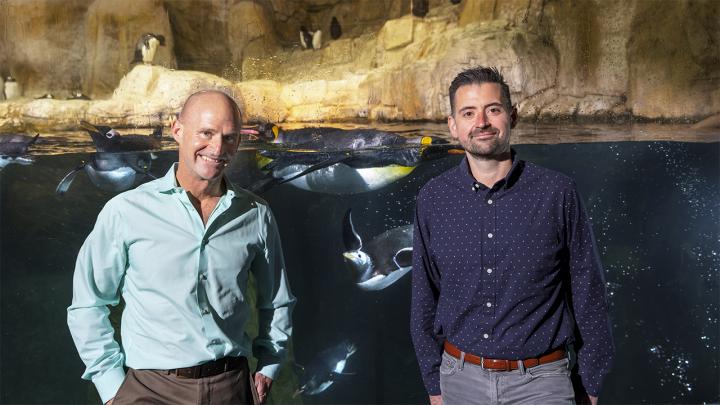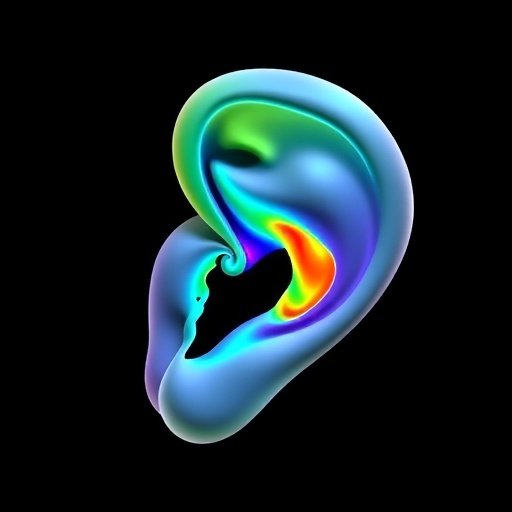Experiments on ancient proteins reveal evolution of better oxygen capture, release

Credit: Craig Chandler, University of Nebraska-Lincoln
Call it the evolutionary march of the penguins.
More than 50 million years ago, the lovable tuxedoed birds began leaving their avian relatives at the shoreline by waddling to the water’s edge and taking a dive in the pursuit of seafood.
Webbed feet, flipper-like wings and unique feathers all helped penguins adapt to their underwater excursions. But new research from the University of Nebraska-Lincoln has shown that the evolution of diving is also in their blood, which optimized its capture and release of oxygen to ensure that penguins wouldn’t waste their breath while holding it.
Relative to land-dwelling birds, penguin blood is known to contain more hemoglobin: the protein that picks up oxygen from the lungs and transports it through the bloodstream before dropping it off at various tissues. That abundance could partly explain the underwater proficiency of, say, the emperor penguin, which dives deeper than any bird and has been documented holding its breath for more than 30 minutes while preying on krill, fish and squid.
Still, the particulars of their hemoglobin — and how much it actually evolved to help penguins become fish-gobbling torpedoes that spend up to half of their lives underwater — remained open questions. So Nebraska biologists Jay Storz and Anthony Signore, who often study the hemoglobin of birds that survive miles above sea level, decided to investigate the birds most adept at diving beneath it.
“There just wasn’t a lot of comparative work on blood-oxygen transport as it relates to diving physiology in penguins and their non-diving relatives,” said Signore, a postdoctoral researcher in Storz’s lab.
Answering those questions meant sketching in the genetic blueprints of two ancient hemoglobins. One belonged to the common ancestor of all penguin species, which began branching from that ancestor about 20 million years ago. The other, dating back roughly 60 million years, resided in the common ancestor of penguins and their closest non-diving relatives — albatrosses, shearwaters and other flying seabirds. The thinking was simple: Because one hemoglobin originated before the emergence of diving in the lineage, and the other after, any major differences between the two would implicate them as important to the evolution of diving in penguins.
Actually comparing the two was less simple. To start, the researchers literally resurrected both proteins by relying on models that factored in the gene sequences of modern hemoglobins to estimate the sequences of their two ancient counterparts. Signore spliced those resulting sequences into E. coli bacteria, which churned out the two ancient proteins. The researchers then ran experiments to evaluate the performance of each.
They found that the hemoglobin from the common ancestor of penguins captured oxygen more readily than did the version present in the blood of the older, non-diving ancestor. That stronger affinity for oxygen would mean less chance of leaving behind traces in the lungs, an especially vital issue among semi-aquatic birds needing to make the most of a single breath while hunting or traveling underwater.
Unfortunately, the very strength of that affinity can present difficulties when hemoglobin arrives at tissues starved for the oxygen it’s carrying.
“Having a greater hemoglobin-oxygen affinity sort of acts like a stronger magnet to pull more oxygen from the lungs,” Signore said. “It’s great in that context. But then you’re at a loss when it’s time to let go.”
Any breath-holding benefits gained by picking up extra oxygen, in other words, can be undone if the hemoglobin struggles to relax its iron-clad grip and release its prized cargo. The probability that it will is dictated in part by acidity and carbon dioxide in the blood. Higher levels of either make hemoglobins more likely to loosen up.
As Storz and Signore expected, the hemoglobin of the recent penguin ancestor was more sensitive to its surrounding pH, with its biochemical grip on oxygen loosening more in response to elevated acidity. And that, Signore said, made the hemoglobin more biochemically attuned to the exertion and oxygen needs of the tissues it served.
“It really is a beautiful system, because tissues that are working hard are becoming acidic,” he said. “They need more oxygen, and hemoglobin’s oxygen affinity is able to shift in response to that acidity to provide more oxygen.
“If pH drops by, say, 0.2 units, the oxygen affinity of penguin hemoglobin is going to decrease by more than would the hemoglobin of their non-diving relatives.”
Together, the findings indicate that as penguins took to the seas, their hemoglobin evolved to maximize both the pick-up and drop-off of available oxygen — especially when it was last inhaled five, or 10, or even 20 minutes earlier. They also illustrate the value of resurrecting proteins that last existed 20, or 40, or even 60 million years ago.
“These results demonstrate how the experimental analysis of ancestral proteins can reveal the mechanisms of biochemical adaptation,” Storz said, “and also shed light on how organismal physiology evolved in response to new environmental challenges.”
###
The team detailed its findings in the journal Proceedings of the National Academy of Sciences. Storz and Signore authored the study with Nebraska’s Hideaki Moriyama, associate professor of biological sciences; Michael Tift of the University of North Carolina Wilmington; Federico Hoffmann of Mississippi State University; and Todd Schmitt of SeaWorld San Diego.
The researchers received support from the National Institutes of Health and the National Science Foundation.
Media Contact
Jay Storz
[email protected]
Related Journal Article
http://dx.




